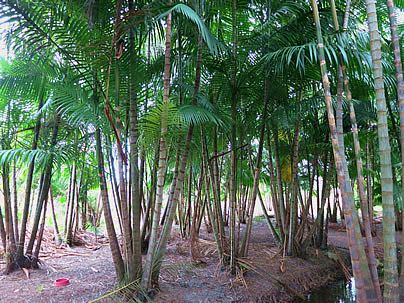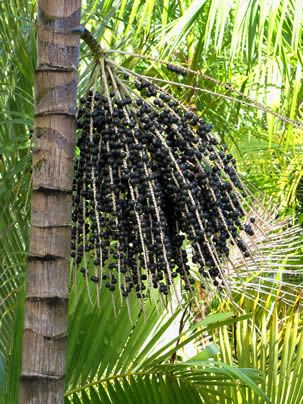The açaí palm (Euterpe oleracea) is a palm native to the Amazon region, whose delicious little fruits, the açaí berries, are widely consumed by the local population and have been gaining popularity in Brazil and around the world over the past few decades. It closely resembles the jussara palm (Euterpe edulis), but differs in being clumping, usually having more than 4 stems per plant, whereas the jussara is a single-stemmed palm.

Each stem is thin and elegant, reaching about 14 cm (5.5 inches) in diameter, with a grayish cortex and an elongated, edible heart of palm, covered by bluish-green leaf sheaths. From the top of the heart of palm emerge the leaves, pinnate, glabrous, and hanging, about one meter (3.3 feet) long. Young plants have bifid leaves which are replaced by adult pinnate leaves as they grow.
The inflorescence is erect to pendulous, in a panicle, with numerous tiny brownish flowers. The following fruits are globular drupes, with dark purple to black skin and pulp when ripe, juicy pulp, and a single hard seed. These fruits can be consumed fresh, although they are much more commonly used in the form of frozen pulp, in the creation of nutritious and tasty preparations, ranging from juices, sorbets, smoothies, porridges with flour or tapioca, sauces, wines, jellies, etc.
The Açaí berries are very nutritious and energizing, containing a high concentration of vitamins, minerals, essential oils, and antioxidant substances, such as anthocyanin, which gives them their purple color.

There’s no need to elaborate much on the qualities of this species; just try a bowl of açaí to be convinced that it should be widely cultivated in our country. Moreover, it is a palm of delicate and elegant beauty, which lends a tropical feel to the landscape without being visually overwhelming. In landscaping, use it in rows along paths or walls, or in mixed groups with other trees and shrubs, composing orchards, small woods, or heterogeneous flowerbeds.
In the initial stages, it is also suitable for pot cultivation, adorning well-lit indoor environments. Beyond the high value of its fruits and its graceful presence in the garden, the açaí palm is endlessly rich, for its edible heart of palm, for attracting wild birds, for its wood, but mainly for playing a fundamental role in the sustainability of local communities, serving as a source of income and food.
Due to its clumping behavior, the açaí palm does not die after the cutting of one of its hearts of palm. This happens because there is more than one stem per plant, allowing for its regeneration, unlike the jussara palm, which does not have this ability to regenerate. Thus, the extraction of açaí heart of palm becomes more interesting ecologically and commercially, allowing for the maintenance of specimens in the forest through sustainable management.

It can initially be cultivated under partial shade and gradually increase the proportion of sunlight hours, until reaching maturity. Although mature plants grow well in full sun, this palm prefers semi-shaded locations, fruiting well under these conditions. The açaizeiro is a floodplain plant, so the soil should be rich in organic matter and receive a good supply of water, especially during flowering and fruiting.
The açaí palm tolerates waterlogging, enjoys tropical heat, and does not tolerate intense cold or frost. In plantations aimed at fruit production, it is recommended to thin the plant, keeping about 4 stems, which then grow faster and become more productive. It multiplies by seeds, obtained from ripe and depulped fruits, planted in moist substrate, and by separation of offshoots (division of clumps).


